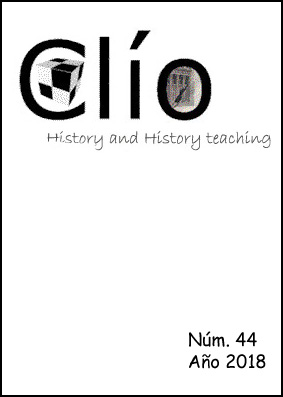The value of history. Study of curricular alternatives at secondary school (1): An integrated vision of the transformations (change/continuity) that lead to and shape the present (historical consciousness)
DOI:
https://doi.org/10.26754/ojs_clio/clio.2018448681Keywords:
curriculum, curricular design, history teaching, historical thinking, historical consciousness, change & continuityAbstract
Giving value to the study of history constitutes the fundamental problem of curricular design. Based on this premise, a series of articles are proposed in which alternative curricular hypothesis for the subjects of history in secondary and baccalaureate are presented, compared to the traditional encyclopedic approach. Each alternative is focused on a particular value, a valuable achievement that configures and gives meaning to a certain curricular orientation. In this first installment, a curriculum oriented to the development of historical consciousness is proposed, through the study of the great processes of transformation (technical, economic, social, political, cultural, geopolitical ...) over time. The student learns in this curriculum to see the historicity of the present, as a fleeting snapshot of a world in constant transformation, to assess its characteristics as the result of those transformation processes, and to analyze the complexity of the processes of change and continuity that are shaping the reality of each historical moment, including its present.
Downloads
References
Booth, A. (2000). Creating a context to enhance student learning of history. En A. Booth, P. Hyland (eds.), The Practice of University History Teaching (pp.31-32). Manchester: Manchester University Press.
Braudel, F. (1958). Histoire et sciences sociales: La longue durée. Annales. Histoire, Sciences Sociales 13(4), 725–753.
Clark, A., & Grever, M. (2018). Historical Consciousness: Conceptualizations and Educational Applications. In S. A. Metzger & L. M. Harris (Eds.), The Wiley International Handbook of History Teaching and Learning (pp. 177-201). New York: Wiley Blackwell.
Counsell, C. (2011). What do we want students to do with historical change and continuity? In I. Davies (Ed.), Debates in History Teaching (pp. 109-123). Oxon & New York: Routledge.
Dawson, I. (2007). Thinking across time: planning and teaching the story of power and democracy at Key Stage. Teaching History(129), 14-22.
Dawson, I. (2012). Seeing the bigger picture. Developing chronological understanding. A summary of points made at London History Forum and at the Northern History Forum 2011/12. http://www.thinkinghistory.co.uk/Issues/SeeingTheBiggerPictureChronology.html
de Groot-Reuvekamp, M. (2017). Timewise: Improving pupils' understanding of historical time in primary school. Universiteit van Amsterdam (tesis doctoral). Consultada de https://dare.uva.nl/search?identifier=b7f872f9-d8b1-4314-a0c7-d71e9da5e8bb
Gadamer, H.-G. (1979). The Problem of Historical Consciousness. In P. Rabinow & W. M. Sullivan (Eds.), Interpretive Social Science. A Reader (pp. 103-160). Berkeley, Los Angeles, London: University of California Press. Original: Louvain, 1963.
Hawkey, K. (2015). Moving forward, looking back – historical perspective, ‘Big History’ and the return of the longue durée: time to develop our scale hopping muscles. Teaching History, 158, 40-46.
Lee, P. J. (2005a). Historical Literacy: Theory and Research. International Journal of Historical Learning, Teaching and Research, 5, 29-40.
Lee, P. J. (2005b). Putting Principles into Practice: Understanding History. In M. S. Donovan & John D. Bransford (Eds.), How students learn: history, mathematics, and science in the classroom (pp. 31). Washington: The National Academies Press.
Lee, P.J. (2011). History education and historical literacy. In I. Davies (Ed.), Debates in History Teaching (pp. 63-72). Oxon & New York: Routledge.
Loewen, J. W. (1995). Lies My Teacher Told Me. Everything Your American History Textbook Got Wrong. New York: Touchstone, Simon & Schuster.
Schubert, W. H. (2009). What is Worthwhile: From Knowing and Needing to Being and Sharing. Journal of Curriculum and Pedagogy 6(1), 21-39
Shemilt, D. (2000). The caliph’s coin: the currency of narrative frameworks in history teaching. In P. Seixas, P. Stearns, & S. Wineburg (Eds.), Knowing, teaching and learning history (pp. 83-101). New York: New York University Press.
Shemilt, D. (2009). Drinking an ocean and pissing a cupful. How Adolescents make sense of history. In L. Symcox & A. Wilschut (Eds.), National history standards. The problem of the canon and the future of teaching history. Charlotte, North Carolina: Information Age Publishing, Inc.
Stanford, M. (2008). ‘Redrawing the Renaissance: non-verbal assessment in Year 7’. Teaching History, 130.
Stenhouse, L. (1985). Investigación y desarrollo del curriculum. Madrid: Morata, 195-198
Downloads
Published
How to Cite
Issue
Section
License
Copyright (c) 2018 Javier Paricio Royo

This work is licensed under a Creative Commons Attribution-NonCommercial-ShareAlike 4.0 International License.
This work is licensed under a Creative Commons Attribution-NonCommercial-ShareAlike 4.0 International License.
Copyright remains the property of authors. Permission to reprint must be obtained from the authors and the contents of JoS cannot be copied for commercial purposes. JoS does, however, reserve the right to future reproduction of articles in hard copy, portable document format (.pdf), or HTML editions of JoS.






